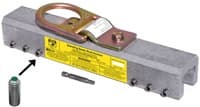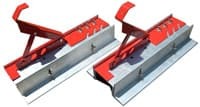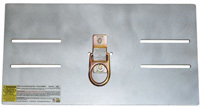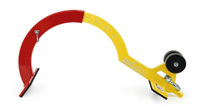Fall Protection Strategies For Northshore Sheet Metals
Posted by Howie Scarboro - CEO Fall Protection Distributors, LLC on Apr 24th 2025
See the Roof Anchor Compatibility Chart for Northshore Sheet Metals Supply Standing Seam Panels.

Who Is Northshore Sheet Metals?
Northshore isn't your average metal shop. Their work appears everywhere, from residential remodels in the North Shore suburbs to commercial buildings downtown.
What sets them apart is their mix of old-school craftsmanship and new-school precision. Whether galvanized steel, copper, aluminum, or zinc, every panel matches the project's unique personality. Historic restoration with an architectural flair? They're on it. Custom-cut panels for a rooftop restaurant? No problem.
With laser-cut edges and a commitment to collaboration, Northshore's team works closely with architects, contractors, and homeowners to bring visions to life. They don't just make metal panels—they make them memorable. Their reputation is rooted in quality, but the personal touch keeps folks returning.
Why Are Compatible Fall Protection Anchors Critical for Standing Seam Roofs?
Standing seam roofs look great from the ground. But if you walk up there without the proper fall protection, you'll quickly discover that looks aren't everything.
These panels aren't like your standard screw-down metal roofing. They feature raised seams that interlock without any exposed fasteners, which is fantastic for weather resistance—but it also means there's no easy place to drill or tie off. And if you do drill, you've just turned that sleek, watertight panel into a leaky liability. That's a one-way ticket to callbacks, warranty voids, and a very unhappy building owner.
That's where compatibility comes into play. Fall protection anchors for standing seam roofs must clamp onto the seams, gripping firmly without penetrating the panel. A good seam-mounted anchor will hold strong under tension without warping the metal or breaking the clean lines the architect spent hours obsessing over.
Using the wrong anchor—or worse, improvising—can cause real damage to the roof and your reputation. We've seen everything from flattened seams to full-blown panel replacements because someone skipped the compatibility check. It's not just a matter of safety compliance. It's about doing the job right, protecting your crew, and preserving the integrity of a costly roof system.
Chicago winters, gusty lakefront winds, and ice storms don't leave room for error. Northshore Sheet Metals builds roofs that last. Make sure your fall protection setup does, too.
Mechanical Lock Standing Seam Panels

Something is reassuring about the sound of a solid click when a panel locks into place. That's the confidence Northshore Sheet Metals brings with its Mechanical Lock standing seam system. Available in copper, aluminum, and high-grade 24 gauge steel, these panels offer a secure fit, timeless aesthetics, and long-term durability that outlasts trends—and possibly a few owners. See the Roof Anchor Compatibility Chart for Northshore Sheet Metals Supply Mechanical Lock Standing Seam Panels.
Choose from seam heights of 1 inch or 1.5 inches and 28 available colors, all backed by the power of a resin-based Kynar 500 coating. That finish isn't just for looks—it stands up to decades of punishment from Chicago's most dramatic weather moods. These panels hold their rain, sleet, snow, or sun.
But make no mistake—installing mechanical lock panels is not for the faint of heart (or under-equipped contractor). These systems require precision crimping tools, roofing know-how, and a healthy respect for detail. However, if you've got the skills, the payoff is a tight, watertight roof system that stays quiet, rigid, and leak-free for the long haul.
Northshore's panels are precision cut with tolerances under 0.01 inch. With a bit of help from thicker 5/8-inch sheathing and modern underlayment, even the occasional rainstorm can't rattle this setup—literally. The proper underlayment cuts down on noise and boosts insulation, so your customer's roof isn't just tough; it's smart.
This profile's male and female seams create a tight join, recommended for roof pitches of 3/12 or greater. Just be mindful—mechanical seams aren't ideal for dead-flat surfaces. Water loves to find a way in, but a good slope tells it to keep moving.
Fall Protection for Mechanical Lock Panels
Your fall protection gear must match a refined standing seam roof system. Compatibility matters more than ever, especially when working with 24-gauge steel panels.
Your best solution for steel roofs in that category starts with the SSRA1 Seam Anchor, the system's core. This non-penetrating anchor clamps directly onto the panel seams without compromising the roof surface. Whether installing solar, staging a repair, or setting up for long-term work, the SSRA1 gives you a safe, secure tie-off point without a single hole in the panel.
Next is the SSRA2 Adjustable Roof Jack Adapter, which mounts onto the SSRA1 anchor and holds a 2x10 wooden walkboard. This adapter plate gives roofers a solid, elevated surface from which to work. The pitch and seam height adjustment allows you to level your board on various roof systems.
Then there's the SSRA3 Anchor Plate—the missing puzzle piece for multi-worker jobs. Once secured on top of the SSRA1 base anchor, this plate becomes your temporary lifeline station. Connect a horizontal lifeline system like the Malta Dynamics HL3001, and you'll get OSHA-compliant protection across up to 100 feet of roof space. The system is modular, tool-free, and completely non-penetrating, protecting your crew and the roof investment below.
Working with aluminum, copper, or any other lighter or non-steel substrate? That's where the Ridge Pro Steep Assist shines—especially on steeper slopes between 6/12 and 12/12. This peak-hooking anchor gives solo or team roofers 100 percent tie-off from the moment they step foot on the slope. It's a no-drill solution that adds real peace of mind, especially when you're miles above the sidewalk and the wind picks up off Lake Michigan.
Bottom line: with the proper setup, you can walk, work, and tie-off on Northshore's Mechanical Lock panels without ever punching a hole. Safety doesn't have to mean sacrifice—and when your equipment and panel system work together, everyone wins.
1-Inch Nailstrip Snaplock Panels

If fast, clean, and tough had a lovechild in the roofing world, it would be Northshore's 1-inch Nailstrip Snaplock panel. Also known as nail flange or fastener flange panels, this profile is the go-to choice for roofers who want quick installs without sacrificing strength or style—especially on residential jobs where time is money and the margin for leaks is zero. See the Roof Anchor Compatibility Chart for Northshore Sheet Metals Supply 1-Inch Nailstrip Standing Seam Panels.
These panels are available in copper, aluminum, and 24 gauge galvanized steel, with a 0.025-inch thickness that means business. Every panel includes pre-punched screw holes spaced every 6 inches, allowing for precise, wind-resistant installation without a fussy clip system. That little detail adds to significant roof benefits: lower labor costs, faster installs, and joints that stay locked even in high winds off Lake Michigan.
Here's where it gets smart: those screw holes also allow the panels to flex with temperature changes. That's a massive plus in Chicagoland, where the forecast can go from sunny to sideways in 20 minutes. Instead of buckling or cracking, the panels breathe—expanding and contracting as needed—so your client gets a roof that lasts and doesn't complain about the weather.
Thanks to snaplock seam technology, these panels create tight, water-resistant joins. You get a nearly impenetrable seal at the most vulnerable points with a good adhesive and careful crimping. While the installation process is simple, Northshore recommends using 5/8-inch sheathing instead of the usual half-inch. It's a minor upgrade that improves rigidity and seam performance, especially on steeper slopes.
Like all sheet metal roofing systems, these panels can carry some acoustic baggage. But pair them with a thicker synthetic underlayment, and you'll get quieter interiors and better thermal insulation. That means lower energy bills and happier homeowners—not to mention fewer questions about the mystery sounds on rainy nights.
Best suited for roofs with a pitch of 3/12 or more, the 1-inch Nailstrip Snaplock panel combines ease of installation with long-term durability. With proper maintenance, zinc-coated panels can last up to 40 years—and they'll look good doing it.
Fall Protection for Nailstrip Panels
Let's talk safety. No matter how good a panel looks, it's not worth much if your crew can't work on it safely. Your best setup for 24 gauge steel Nailstrip panels is the three-part system built around the SSRA1 Seam Anchor.
This anchor clamps directly onto the panel seam without penetrating it. That means your beautiful roof stays leak-free, and your crew gets a secure tie-off point that meets OSHA standards: no holes, no corrosion, no problem.
Add the SSRA2 Adjustable Roof Jack Adapter to that anchor, and you have a secure platform for a 2x10 walkboard. The jack adapter adjusts to accommodate different seam spacing, giving you a level walking surface even on slightly uneven panel layouts.
For projects with multiple workers or larger work zones, top off your anchor with the SSRA3 Anchor Plate. This plate transforms the anchor into a horizontal lifeline base. Pair it with a 100-foot Malta Dynamics lifeline system, and your team will have continuous tie-off protection across wide roof spans—no drilling, patching, or regrets.
Working on copper, aluminum, or other lighter-gauge panels? Go with the Ridge Pro Steep Assist Anchor on roofs with a 6/12 to 12/12 pitch. It hooks securely over the peak and offers a fast, reliable way to stay tied off from the moment your boots touch the roof. It's ideal for single-worker jobs or any panel type where clamp anchors aren't an option.
In short, don't let safety be the weak link in your project. With the right fall protection system, you can work smarter, protect your crew, and keep that Northshore panel looking as flawless as the day it rolled off the line.
Snaplock Standing Seam Panels

There's a reason Snaplock panels are a roofer's best friend. Quick to install, tough as nails, and sleek enough to win over even the pickiest architect, these panels from Northshore Sheet Metals hit the sweet spot between durability, aesthetics, and ease of installation. If you've got a residential or light commercial job and want to wrap it up fast without cutting corners, this is the panel profile you'll want in the truck. See the Roof Anchor Compatibility Chart for Northshore Sheet Metals Supply Snaplock Standing Seam Panels.
These panels are copper, aluminum, or 24 gauge galvanized steel and have a 1-inch or 1.5-inch seam height. Each is 0.025-inch galvalume-coated steel—tough enough to withstand Chicago winters without flinching. When installed correctly, this system can deliver up to 40 years of leak-free performance while looking sharp the whole way through.
Snaplock panels connect using male and female seams that snap together securely without mechanical seaming. That means fewer tools, less labor, and faster installs—even for roofers who are newer to the trade. And because the seam stands tall, even if one connection gets dinged or warped, runoff still flows safely away from the underlayment.
These panels are best suited for roof pitches of 3/12 and up. Lower than that, and you risk ponding water trying to sneak in through the seams—something no roofer wants to deal with during warranty calls. Want to maximize rigidity and keep those joints locked in? Swap that half-inch sheathing for a 5/8-inch deck. It's a small detail that delivers a big difference in long-term performance.
Like most metal panels, Snaplock systems can carry a bit of noise in heavy rain or hail. That said, a modern synthetic underlayment does a great job of dampening sound while adding a layer of insulation. It's a smart way to reduce echo inside and reduce HVAC bills year-round.
Fall Protection for Snaplock Panels
Just because Snaplock panels are easy to install doesn't mean you can take fall protection lightly. In fact, with smooth metal surfaces and higher roof pitches, safety becomes even more critical.
If you're working on 24 gauge steel panels, start with the SSRA1 Seam Anchor. This clamp-on anchor creates a secure, non-penetrating tie-off point right on the panel seam—no drills, holes, or risk to the roof's watertight barrier. It's OSHA-compliant, easy to install, and built for real-world job sites.
Add an SSRA2 Adjustable Roof Jack Adapter to the setup, and you're in business. This component mounts on the SSRA1 and holds a 2x10 wooden walkboard, giving your crew a steady working platform. It's beneficial for moving materials, accessing difficult areas, or performing detailed installs without teetering on the panels.
For jobs that require more mobility or multiple users, add the SSRA3 Anchor Plate. This plate locks into the SSRA1 and serves as a mount point for a horizontal lifeline. When paired with something like the Malta Dynamics HL3001 100-foot lifeline system, your crew gets continuous tie-off protection from end to end, all without a single roof penetration.
If your Snaplock panels are aluminum or copper—or you're working with any other lighter substrate—go with the Ridge Pro Steep Assist on 6/12 to 12/12 pitched roofs. It hooks over the ridge cap and provides an instant tie-off point for solo work, giving roofers peace of mind from the first step.
Batten Lock Standing Seam Panels

There's something undeniably clean and elegant about a batten-style standing seam roof. Northshore Sheet Metals has embraced that design with its snap-on Batten Lock panels—also called U-lock panels—and given it a modern twist. Available in copper, aluminum, and 24 gauge galvanized steel, these panels are a top choice for residential roofing projects where both form and function matter. See the Roof Anchor Compatibility Chart for Northshore Sheet Metals Supply Batten Lock Standing Seam Panels.
What makes Batten Lock panels unique is the addition of a raised cap that snaps over the seam. This extra layer protects the panel joints from water intrusion while creating a strong visual line that architects and designers love. From sleek modern homes to custom residential builds, these panels bring sophistication to the rooftop with long, clean lines and a wide range of available colors.
Panels can be up to 35 feet long, making them ideal for large, uninterrupted roof planes. The clip system used for installation allows for secure attachment without visible fasteners, and those clips also enable the panels to expand and contract with changing temperatures. That's a significant plus in the Midwest, where weather can go from hot to hailstorm in an afternoon.
With a core of 0.025-inch zinc-coated steel, Northshore's batten panels are durable. Expect up to 50 years of reliable performance, provided they're installed correctly and paired with a slightly thicker 5/8-inch sheathing to reduce joint flex and increase rigidity. That combination keeps the roof system tight, secure, and ready for whatever Chicago weather has in store.
A little noise is part of the package, as is all metal roofing. But that's where underlayment matters. Opt for a modern synthetic version with enhanced thickness and sound absorption, and you'll reduce both roof noise and heating bills.
These panels perform best on roofs with a pitch of 3/12 or more. While the batten cap helps resist leaks, standing water is risky on flatter slopes. Keep that pitch steep and your worries low.
Fall Protection for Batten Lock Panels
Batten Lock panels may look amazing, but they throw a curveball for fall protection. Unlike typical standing seam systems, these panels feature a full seam cap that makes them incompatible with clamp-on anchors like the SSRA1, SSRA2, and SSRA3.
That's where the Ridge Pro Steep Assist Anchor steps in. For roof pitches between 6/12 and 12/12, the Ridge Pro offers a fast, secure solution that doesn't rely on seam-mounted gear. It hooks over the roof's ridge, creating a stable tie-off point without penetrating the panel or interfering with the batten system.
This solution makes it ideal for contractors or inspectors working on residential Batten Lock roofs—especially in cases where they need temporary, portable safety gear without compromising aesthetics or panel integrity. The Ridge Pro gives you 100 percent tie-off capability from the moment you start climbing until the last panel is in place.
While Batten Lock panels aren't compatible with most seam-mounted anchors, safety on these stylish systems is still entirely achievable. Just match your fall protection approach to the panel's unique characteristics. You can protect your team and the roof with the right gear and proper planning.
Metal Roof Anchor Panel Compatibility For Northshore Sheet Metals Supply
| Mechanical Lock 24 ga. |
Nailstrip 24 ga. |
Snaplock 24 ga. |
Batten Lock U Lock |
|
|---|---|---|---|---|
| YES | YES | YES | NO | |
| YES | YES | YES | NO | |
| YES | YES | YES | NO | |
| YES | YES | YES | NO | |
| YES | YES | YES | YES |
Contact Us For More Information
For further details on roofing solutions and fall protection systems, contact us at 863-703-4522 or www.StandingSeamRoofAnchor.com. Let's work together to make your roofing projects safe, beautiful, and built to last. For more safety tips, check out OSHA's 48-page fall protection manual. Once you have determined the most suitable anchors for your roof system, download our free Anchor Inspection Form.
Safety Tips For Standing Seam Roofs
Ensure Proper Footwear for Stability
No matter how skilled your crew is, poor traction can quickly bring them down. Metal roofs demand boots with serious grip. Slip-resistant soles with deep treads and firm ankle support give workers the edge to stay balanced on slick or sloped surfaces. Proper footwear doesn't just add comfort—it's your first defense against gravity.
Use Specialized Anchor Systems for Standing Seam Roofs
Standing seam panels aren't your average roof surface, and drilling into them is asking for trouble. Instead, opt for seam-mounted anchors clamping onto panel ribs without a puncture. These anchors offer secure, OSHA-approved tie-off points and preserve the panel's integrity, warranty, and weather resistance—no compromises necessary.
Equip Workers with High-Quality Safety Gear
When gear fits well and performs flawlessly, it stops being a burden and becomes a habit. Ensure every crew member has harnesses, lanyards, and SRLs designed for rooftop work. Comfortable gear leads to consistent use, and consistent use saves lives.
Set Up Protective Guardrail Barriers for Work Zones
Guardrails are like invisible teammates—they're always there, working quietly to keep everyone safe. They provide instant, passive protection around roof edges, skylights, or open sections. Especially on hectic commercial sites, guardrails reduce workers' mental load so they can focus on the job instead of worrying about where not to step.
Develop OSHA-Compliant Safety Plans
Flying blind on a roof job is not a good idea. OSHA-compliant plans should detail fall protection systems, known hazards, emergency rescue procedures, and each crew member's responsibilities. A clear plan turns guesswork into guidance and transforms confusion into accountability, ensuring safer outcomes from day one.
Encourage the Use of Trauma Straps
A fall arrest system might stop the fall—but what about the aftermath? Suspension trauma can set in within minutes. Trauma straps let a worker relieve pressure and improve circulation while awaiting rescue. It's a lightweight piece of gear that buys critical time—and can make all the difference during an emergency.
Promote a Culture of Safety
A pile of written rules won't prevent a fall—people will. When safety becomes part of daily conversations and attitudes, it changes behavior. From pre-shift meetings to open-door feedback, encouraging workers to speak up and look out for each other builds a proactive, safety-first mindset that can outlast any checklist.
Install Permanent Roof Anchor Systems
Some jobs are one-and-done, while others require regular return visits. For the latter, permanent anchors are a no-brainer. Fixed to the roof for ongoing use, they eliminate setup hassles and ensure safe access for maintenance crews, HVAC techs, or anyone else who needs to get up there regularly. Less time rigging means more time working—safely.
Prioritize Ladder Safety Training
You can't work a roof if you don't get there in one piece. Ladder mishaps remain one of the leading causes of job site injuries. Teach your team to inspect ladders, use the 4-to-1 angle rule, and always maintain three points of contact. A stable climb sets the tone for a safe project.
Consult Experts for Curved Metal Panels
Curved roofs may look sleek, but they come with hidden dangers. Many anchors aren't made for radius panels—forcing the issue can damage the roof or cause anchor failure. Before tackling a curved surface, consult a safety professional to determine the right system. Custom solutions protect both your crew and your craftsmanship.
Disclaimer
The views, recommendations, and information presented in this blog are solely those of the author and do not necessarily reflect the opinions or positions of the featured panel manufacturer, its brands, subsidiaries, or parent companies. Customers are strongly encouraged to reach out directly to the roof panel manufacturer for inquiries regarding fall protection compatibility with their products and to address any potential warranty issues that may arise following the installation of our products.






